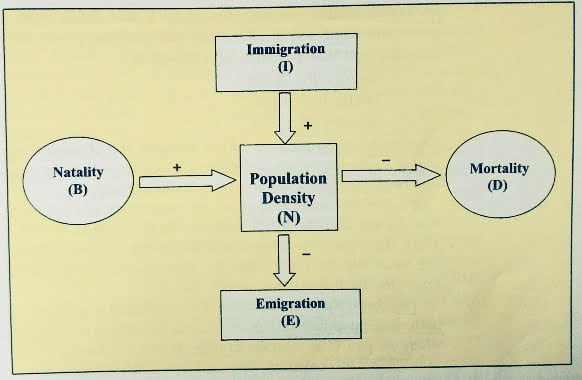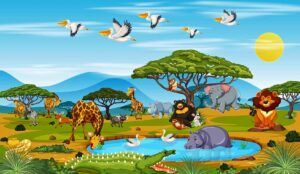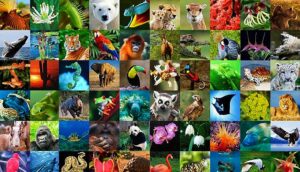Population :-
A population may be defined as a group of organisms of the same species occupying a certain area or space at a given time .
- The term interbreeding implies sexual reproduction , a group of individuals resulting from even asexual reproduction is also generally considered a population for the purpose of ecological studies .
population Attributes :-
A population has certain attributes that and individual organism does not . An individual may have births and deaths , but a population has birth rates and death rates .
- In a population these rates refer to per capita births and deaths respectively . The rates hence , expressed is change in numbers ( increase or decrease ) with respect to members of the population .
Examples – If in a pond there are 20 Lotus plants last year and through reproduction 8 new plants are added , taking the current population to 28 , we calculate the birth rate as 8 / 20 = 0.4 offspring per lotus per year .
If 4 individuals in a laboratory population of 40 fruitflies died during a specified time interval , say a week , the death rate in the population during the period is 4 / 40 = 0.1 individuals per fruitflies per week .
- An individual is either a male or a female but a population has a sex ratio ( example – 60% of the population are females and 40% males ) .
- A population at any given time is composed of individuals of different ages . If the age distribution ( percent individuals of given age or age group ) is plotted for the population , the resulting structure is called an age pyramid .
- The shape of the pyramids reflects the growth status of the population – ( a ) Expanding . ( b ) Stable . ( c ) Declining .

- population size more technically called population density (N).
Population density ( N ) = Total number of organisms ( n ) / Area ( S )
Population growth :-
The size of a population for any species is not a static parameter . It keeps changing in time , depending on various factors including food availability , Predation pressure and adverse weather .
- The density of a population in a given habitat during a given period, fluctuates due to changes in four basic processes – natality, immigration, mortality and emigration.
1 . Natality ( B ) :-
It refers to the number of births during a given period in the population that are added to the initial density .
2 . Mortality ( D ) :-
It is the number of deaths in the population during a given period .
3 . Immigration ( I ) :-
It is the number of individuals of the same species that have come into the habitat from elsewhere during the time period under consideration .
4 . Emigration ( E ) :-
It is the number of individuals of the population who left the habitat and gone elsewhere during the time period under consideration .

If N is the population density at time t ,then its density at time t + I is
N’ = N + { ( B + I ) – ( D + E ) }
From the above equation that population density will increase if the number of births + number of immigration ( B + I ) is more than the number of deaths + the number of emigrants ( D + E ) , otherwise it will decrease .
Exponential growth :-
When resources (food and spaces) in the habitat are unlimited , each species has the ability to realise fully its innate potential to grow in number , as Darwin observed while developing his theory of natural selection . then the population grows in an exponential or geometric fashion .
- If in a population of size N , the birth rates ( not total number but per capita births ) are represented as b and therefore it raids organ per capita death rates ( again , per capita death rates ) as d , then the increase or decrease in N during a unit time period t ( dN / dt ) will be –
dN / dt = ( b – d ) × N
Let ( b – d ) = r , then
dN / dt = rN
The r in this equation is called the intrinsic rate of natural increase.
The above equation describes the exponential or geometric growth pattern of a population and results in a J shaped curve when we plot N in relation to time .

Logistic growth :-
A population growing in a habitat with limited resources show initially a large phase . Followed by phases of acceleration and deceleration and finally an asymptote ,
when the population density reaches the carrying capacity . A lot of N in relation to time ‘t’ results in a sigmoid curve . This type of population growth is called Verhulst-Pear Logistic Growth and is described by the following equation –
dN / dt = rN ( K – N ) / K
Where N = population density at time t , r = Intrinsic rate of natural increase and K = Carrying capacity .
Population Interactions :-
Interspecific interactions arise from the interaction of populations of two different species . They could be beneficial , detrimental or neutral ( neither harm nor benefit ) to one of the species or both . Assigning a ( + ) sign for beneficial interaction , ( – ) sign for mental and (0 ) for neutral interaction .

Predation :-
Predation only one species benefits ( parasite and Predator , respectively ) and the the interaction is detrimental to the other species ( host and prey respectively ) .
For energy transfer across trophic levels , Predator play Other important roles . they keep prey populations under control . But for Predators , Prey species could achieve high population densities and cause ecosystem instability .
when certain exotic species are introduced into a geographical area , they come invasive and start spreading fast because the invaded land does not have its natural predators .
If a Predator is too efficient and overexploits its sprey , then the prey might become extinct and following it . The Predator will also become extinct for lack of food .
Competition :-
When Darwin spoke of the struggle for existence and survival of the fittest in nature , he was convinced that interspecific competition is a potent force in organic evolution .
It is generally believed that competition occurs when closely related species compete for the same resources that are limiting , totally unrelated species could also compete for the same resource .
For instance ,in some shallow South American lakes visiting flamingoes and resident fishes compete for their common food .,the zooplankton in the lake . Secondly , resources need not be limiting for competition to occur , in interference competition , the feeding efficiency of one species might be reduced due to the interfering and inhibitory presence of the other species , even if resources ( food and space ) are aboundant .
- Gauss’s Competitive Exclusion Principle states that two closely related species competing for the same resources cannot co -exist indefinitely and the competitively inferior one will be eliminated eventually .
Parasitism :-
Main parasites have evolved to be host-specific ( they can parasitise only a single species of host ).
- The life cycle of parasites are often Complex , involving one or two intermediate hosts or vectors to facilitate parasitisation of its primary host .
- The human liver fluke ( a trematodes parasite ) depends on two intermediate hosts ( a snail and fish ) to complete its life cycle .
- The malaria parasite needs a vector ( mosquito ) to spread to other hosts . Majority of the parasites harm the host , they may reduce the survival , growth and reproduction of the host and reduce its population density .
- Parasites that feed on the external surface of the host organism are called ectoparasites . The most familiar examples of this group are the lice on humans and ticks on dogs .
Cuscuta , a parasitic plant that is commonly found growing on hedge plants , has lost its chlorophyll and leaves in the cource of evolution .
- In contrast , endoparasites are those that live inside the host body at different sites ( liver , kidney , lungs , red blood cells etc .) . The life cycle of endoparasites are more Complex because of their extreme specialisation .
Commensalism :-
There is the interaction in which one species benefits and the other is neither harmed nor benefited . An Orchid growing as an epiphyte on a mango branch , and barnacles growing on the back of a whale benefit while neither the mango tree not the whale derives any apparent benefit .
Mutualism :-
This interaction confers benefits on both the interacting species . Lichens represent an intimate mutualistic relationship between a fungus and photosynthesising algae or cyanobacteria .
Similarly , the Mycorrhizae are associations between fungi and the roots of higher plants . The fungi help the plant in the absorption of essential nutrients from the soil while the plant in turn provides the fungi with energy yielding carbohydrates .
Adaptations :-
Adaptation is any attribute of the organism ( morphological , physiological , behavioral ) that enables the organism to survive and reproduce in its habitat .
- Many adaptations have evolved over a long evolutionary time and are generated fixed . In the absence of an external source of water , the Kangaroo rat in North American desert is capable of meeting all its water requirements through its internal fat oxidation ( in which water is a by product ) . It also has the ability to concentrate its urine so that minimal volume of water is used to remove excretory products .
- Many desert plants have a thick cuticle on their leaf surfaces and have their stomata arranged in deep pits to minimise water loss through transpiration . They also have a special photosynthetic pathway that enables their stomata to remain closed during day time .


- Some desert plants like Opuntia , have no leaves they are reduced to spines and the photosynthetic function is taken over by the flattened stems .
- Mammals from colder climates generally have shorter ears and Limbs to minimise heat loss . ( This is called the Allen’s rule .) In the polar Seas aquatic mammals like seals have a thick layer of fat ( blubber ) below their skin that acts as an insulator and reduces loss of body heat .
- Some organisms possess adaptations that are physiological which allow them to respond quickly to a stressful situation . Many tribes live in the high altitude of Himalayas . Find out if they normally have higher red blood cell count ( or total haemoglobin ) than people living in the plains .
- In most animals , the metabolic reactions and hence all the physiological functions proceed optimally in a narrow temperature range ( in humans , it is 37⁰C ) . But there are microbes (archaebacteria ) that flourish in hot springs and deep sea hydrothermal vents where temperature far exceed 100⁰C .
- Many fish thrive in Antarctic waters where the temperature is always below zero . A large variety of marine invertebrates and fish live at great depths in the ocean where the pressure could be > 100 times the normal atmospheric pressure that we experience .
- some organisms show behavioural responses to cope with variations in their environment . Desert lizards lack the physiological ability that mammals have to deal with the high temperatures of their habitat , but manage to keep their body temperature fairly constant by behavioral means . They bask in the sun and absorb heat when their body temperature drops below the comfort zone , but move into shade when the ambient temperature starts increasing .
- Some species are capable of burrowing into the soil to hide and escape from the above ground heat .



